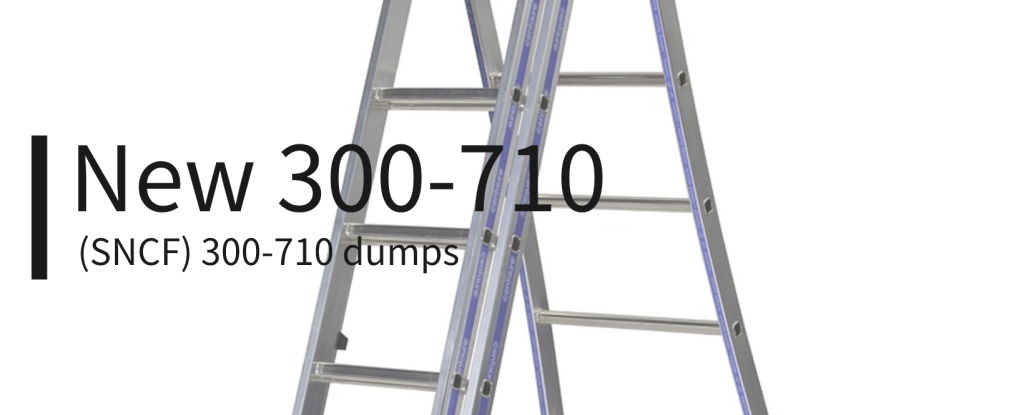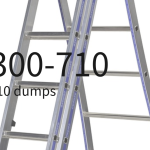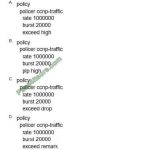
Gain an important stepping stone in your career by successfully passing the Cisco CCNP 300-710 (SNCF) exam by using the new 300-710 dumps new practice questions.
Are you preparing for the Securing Networks with Cisco Firepower (SNCF) 300-710 exam? Pass4itSure is here to provide you with the most reliable and new 300-710 dumps (New 300-710 practice questions 291+) https://www.pass4itsure.com/300-710.html PDF+VCE to pass the exam with confidence.
Keep sharing, new 300-710 dumps practice questions
Following the last time (free 300-710 dumps practice questions Q1-Q15), continue to share new practice questions Q16-Q30:
Question 16:
A Cisco FMC administrator wants to configure the fastpathing of trusted network traffic to increase performance. In which type of policy would the administrator configure this feature?
A. Network Analysis policy
B. Identity policy
C. Prefilter policy
D. Intrusion policy
Correct Answer: C
Question 17:
An organization has implemented Cisco Firepower without IPS capabilities and now wants to enable inspection for their traffic. They need to be able to detect protocol anomalies and utilize the Snort rule sets to detect malicious behavior. How is this accomplished?
A. Modify the network discovery policy to detect new hosts to inspect.
B. Modify the access control policy to redirect interesting traffic to the engine.
C. Modify the intrusion policy to determine the minimum severity of an event to inspect.
D. Modify the network analysis policy to process the packets for inspection.
Correct Answer: B
Each rule in the ACP has control over whether the traffic is sent to Snort to be inspected or not. If the traffic is allowed and an intrusion policy is selected, then the traffic will go on to be inspected by snort.
Reference:
Question 18:
Which limitation applies to Cisco FMC dashboards in a multi-domain environment?
A. Child domains can view but not edit dashboards that originate from an ancestor domain.
B. Child domains have access to only a limited set of widgets from ancestor domains.
C. Only the administrator of the top ancestor domain can view dashboards.
D. Child domains are not able to view dashboards that originate from an ancestor domain.
Correct Answer: D
Question 19:
What is the difference between inline and inline tap on Cisco Firepower?
A. Inline tap mode can send a copy of the traffic to another device.
B. Inline tap mode does full packet capture.
C. Inline mode cannot do SSL decryption.
D. Inline mode can drop malicious traffic.
Correct Answer: D
INLINE TAP
Copies the data to the SNORT Engine to be checked but then dropped while the actual data flow continues uninterrupted. Therefore, INLINE TAP does not send traffic to another device.
The Data is copied but not captured. You still would need to enable packet capture to capture packets (AKA Save PCAP).
INLINE:
Both inline and Inline Tap modes do not support SSL Decryption-resign… Although I’m a bit conflicted by this…
The truth is that Inline Mode can DROP malicious traffic but remember that Inline TAP mode CANNOT. Again this is because tap mode sends a copy of the data to be inspected but not the actual data.
Question 20:
An engineer is building a new access control policy using Cisco FMC. The policy must inspect a unique IPS policy as well as log rule matching. Which action must be taken to meet these requirements?
A. Configure an IPS policy and enable per-rule logging.
B. Disable the default IPS policy and enable global logging.
C. Configure an IPS policy and enable global logging.
D. Disable the default IPS policy and enable per-rule logging.
Correct Answer: C
There is no per-rule logging on the system. Also, there would be no need to log the ACL rule as an Intrusion event will cause the rule to generate an event.
Question 21:
When creating a report template, how can the results be limited to show only the activity of a specific subnet?
A. Create a custom search in the Firepower Management Center and select it in each section of the report.
B. Add an Input Parameter in the Advanced Settings of the report, and set the type to Network/IP.
C. Add a Table View section to the report with the Search field defined as the network in CIDR format.
D. Select IP Address as the X-Axis in each section of the report.
Correct Answer: B
Question 22:
An engineer is reviewing a ticket that requests to allow traffic for some devices that must connect to a server over 8699/udp. The request mentions only one IP address, 172.16.18.15, but the requestor asked for the engineer to open the port for all machines that have been trying to connect to it over the last week.
Which action must the engineer take to troubleshoot this issue?
A. Use the context explorer to see the application blocks by protocol.
B. Use the context explorer to see the destination port blocks
C. Filter the connection events by the source port 8699/udp.
D. Filter the connection events by the destination port 8699/udp.
Correct Answer: D
Question 23:
An engineer is setting up a new Firepower deployment and is looking at the default FMC policies to start the implementation. During the initial trial phase, the organization wants to test some common Snort rules while still allowing the majority of network traffic to pass. Which default policy should be used?
A. Balanced Security and Connectivity
B. Security Over Connectivity
C. Maximum Detection
D. Connectivity Over Security
Correct Answer: A
Balanced Security and Connectivity network analysis and intrusion policies
These policies are built for both speed and detection. Used together, they serve as a good starting point for most networks and deployment types. The system uses the Balanced Security and Connectivity network analysis policy as the default. https://www.cisco.com/c/en/us/td/docs/security/firepower/670/fdm/fptd-fdm-config-guide-670/fptd-fdm-intrusion.html
Question 24:
What is the maximum bit size that Cisco FMC supports for HTTPS certificates?
A. 1024
B. 8192
C. 4096
D. 2048
Correct Answer: C
Question 25:
An Engineer has been asked to show application usage automatically every month and send the information to management. What mechanism should be used to accomplish this task?
A. Event viewer
B. Reports
C. dashboards
D. context explorer
Correct Answer: B
Question 26:
An administrator is working on a migration from Cisco ASA to the Cisco FTD appliance and needs to test the rules without disrupting the traffic. Which policy type should be used to configure the ASA rules during this phase of the migration?
A. Prefilter
B. Intrusion
C. Access Control
D. Identity
Correct Answer: C
Question 27:
An engineer is using the configure manager add Cisc404225383 command to add a new Cisco FTD device to the Cisco FMC; however, the device is not being added. Why is this occurring?
A. DONOTRESOLVE must be added to the command
B. The IP address used should be that of the Cisco FTD, not the Cisco FMC
C. The registration key is missing from the command
D. The NAT ID is required since the Cisco FMC is behind a NAT device
Correct Answer: D
Question 28:
An engineer is tasked with deploying an internal perimeter firewall that will support multiple DMZs Each DMZ has a unique private IP subnet range. How is this requirement satisfied?
A. Deploy the firewall in transparent mode with access control policies.
B. Deploy the firewall in routed mode with access control policies.
C. Deploy the firewall in routed mode with NAT configured.
D. Deploy the firewall in transparent mode with NAT configured.
Correct Answer: C
Question 29:
Which command should be used on the Cisco FTD CLI to capture all the packets that hit an interface?
A. configure core dump packet engine enable
B. capture-traffic
C. capture
D. capture WORD
Correct Answer: C
Reason: the command “capture-traffic” is used for SNORT Engine Captures. To capture a LINA Engine Capture, you use the “capture” command. Since the Lina Engine represents the actual physical interface of the device, “capture” is the only reasonable choice
The command is firepower# capture DMZ interface dmz trace detail match ip host 192.168.76.14 host 192.168.76.100 firepower# capture INSIDE interface inside trace detail match ip host 192.168.76.14 host 192.168.75.14
Question 30:
An organization is configuring a new Cisco Firepower High Availability deployment. Which action must be taken to ensure that failover is as seamless as possible to end users?
A. Set the same FQDN for both chassis.
B. Set up a virtual failover MAC address between chassis.
C. Load the same software version on both chassis.
D. Use a dedicated stateful link between chassis.
Correct Answer: D
The 15 exam questions shared are from Pass4itSure. This is just part of the full 300-710 dumps, all of which have 291 practice questions in the new 300-710 dumps.
New Cisco 300-710 dumps new 300-710 exams
Before you begin, you should be aware of the exam. To put it simply: the Cisco 300-710 SNCF exam is 90 minutes long, you need to answer 55-65 exam questions, the exam is in English, and it costs $300 to take the exam. Certifications related to the exam are CCNP Security and Cisco Certified Specialist – Network Security Firepower.
New 300-710 SNCF exam tips and learning resources
Official Cisco Training:
Securing Networks with Cisco Firepower Next Generation Firewall (SSNGFW)
Securing Networks with Cisco Firepower Next-Generation IPS (SSFIPS)
SNCF training videos
Book:
Books are the traditional way to find the foundation of any technology. Just reading the theory and you might get bored. However, they are just as important as any actual meeting. Books provide a framework for you to build your expertise.
CCNP Security Virtual Private Networks SVPN 300-730 Official Cert Guide
CCNP Security Cisco Secure Firewall and Intrusion Prevention System Official Cert Guide 1st Edition
Tips:
Improve your time management skills.
It boosts your confidence and allows you to focus more on solving the Cisco exam 300-710 questions.
Of course, there are certainly more than that, and the above is just a list of the most important and useful.
Finally, answer the most concerned questions about the 300-710 exam
Where can I get all Cisco Series including Cisco 300-710 exam questions?
You can follow www.exampass.net this blog for occasional updates with a full range of new Cisco exam questions.
How to Use the Latest 300-710 dumps to pass the exam?
The new version of Pass4itSure 300-710 dumps can help you pass the exam, practice Xi Cisco 300-710 exam questions, and update Securing Networks with Cisco Firepower (SNCF) pdf dumps. This Cisco 300-710 dump is the pass key for the real Cisco 300-710 exam.
Summary:
With the Pass4itSure new 300-710 dumps, you can pass the 300-710 exam effortlessly and excel in your career.
Download now the new 300-710 dumps PDF+VCE https://www.pass4itsure.com/300-710.html reliable exam preparation resources.

